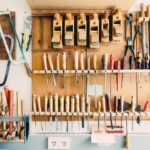Basic hand tools are essential for DIY enthusiasts and professional tradespeople. These manually operated tools are crucial for various tasks. Common basic hand tools include hammers, screwdrivers, pliers, wrenches, and hand saws.
Hammers are used for driving nails and breaking objects. Types include claw hammers, ball-peen hammers, and sledgehammers, each designed for specific tasks. Screwdrivers come in various sizes and types, such as flathead and Phillips head, used for driving screws into or out of surfaces.
Pliers are versatile tools for gripping, bending, and cutting materials, available in different shapes and sizes like needle-nose pliers, cutting pliers, and locking pliers. Wrenches tighten or loosen nuts and bolts and include adjustable wrenches, socket wrenches, and open-end wrenches. Hand saws cut wood and have different tooth patterns and blade lengths for various cutting tasks.
Other basic hand tools include tape measures, levels, utility knives, and chisels. Tape measures are used for measuring distances and come in various lengths and materials. Levels ensure surfaces are straight and even, available in different sizes and types like bubble levels and laser levels.
Utility knives cut materials such as cardboard, plastic, and drywall. Chisels carve and shape wood and come in various shapes and sizes for different woodworking tasks. Basic hand tools are versatile and essential for any workshop or toolbox.
They are crucial for efficiently and effectively completing a wide range of tasks, whether for DIY projects or professional work.
Key Takeaways
- Basic hand tools are essential for any DIY project and include items such as hammers, screwdrivers, pliers, and wrenches.
- Power tools, such as drills, saws, and sanders, can make tasks easier and more efficient, but require proper training and safety precautions.
- Measuring and marking tools, like tape measures, levels, and chalk lines, are crucial for ensuring accuracy in any project.
- Fastening tools, including nails, screws, and bolts, are necessary for securing materials together and come in a variety of sizes and types.
- Cutting tools, such as utility knives, saws, and scissors, are used for shaping and trimming materials to the desired size and shape.
- Safety equipment, like goggles, gloves, and ear protection, is essential for protecting yourself from potential hazards while working with tools.
- Storage and organization solutions, such as toolboxes, pegboards, and shelves, help keep tools and equipment organized and easily accessible.
Power Tools
Types of Power Tools
Some of the most common power tools include drills, saws, sanders, grinders, and nail guns. Drills are versatile power tools used for drilling holes and driving screws into surfaces. They come in various types, such as corded drills, cordless drills, hammer drills, and impact drivers, each designed for specific drilling tasks. Saws are used for cutting materials such as wood, metal, and plastic and come in various types, including circular saws, jigsaws, reciprocating saws, and miter saws.
Specialized Power Tools
Sanders are used for smoothing surfaces and removing material, and they come in different types such as belt sanders, orbital sanders, and random orbital sanders. Grinders are used for cutting, grinding, and polishing materials such as metal and stone and come in various types such as angle grinders and bench grinders. Nail guns are used for quickly and efficiently driving nails into surfaces and come in different types such as brad nailers, finish nailers, and framing nailers.
Additional Power Tools and Their Importance
In addition to these tools, other power tools include routers, planers, rotary tools, and heat guns. Routers are used for hollowing out an area in a piece of wood or plastic and come in various types such as plunge routers and fixed-base routers. Planers are used for shaving wood to create a smooth surface and come in different types such as hand planers and thickness planers. Rotary tools are versatile handheld power tools used for cutting, grinding, sanding, and polishing materials such as wood, metal, and plastic. Heat guns are used for applying heat to materials to soften paint or adhesive for removal. Power tools are essential for any workshop or construction site, as they can make tasks faster, easier, and more precise. Whether you are a professional tradesperson or a DIY enthusiast, having a good set of power tools is crucial for completing projects efficiently and effectively.
Measuring and Marking Tools

Measuring and marking tools are essential for any construction or woodworking project, as they ensure accuracy and precision in the layout and cutting of materials. These tools are designed to measure distances, angles, and dimensions accurately and to mark surfaces for cutting or installation. Some of the most common measuring and marking tools include tape measures, squares, levels, marking gauges, and chalk lines.
Tape measures are essential for measuring distances accurately and come in various lengths and materials such as steel or fiberglass. Squares are used for marking right angles and ensuring surfaces are square and come in various types such as framing squares, speed squares, combination squares, and try squares. Levels are used for ensuring surfaces are straight and even and come in different sizes and types such as bubble levels and laser levels.
Marking gauges are used for marking precise measurements on wood or other materials before cutting or shaping them. Chalk lines are used for marking long straight lines on surfaces such as walls or floors before installation or construction tasks. In addition to these tools, other measuring and marking tools include calipers, protractors, bevel gauges, and rulers.
Calipers are used for measuring the distance between two opposite sides of an object accurately. Protractors are used for measuring angles accurately and come in various types such as digital protractors and adjustable protractors. Bevel gauges are used for measuring angles on wood or other materials accurately before cutting or shaping them.
Rulers are essential for measuring short distances accurately and come in various lengths and materials such as steel or aluminum. Measuring and marking tools are essential for any workshop or construction site, as they ensure accuracy and precision in the layout and cutting of materials. Whether you are a professional tradesperson or a DIY enthusiast, having a good set of measuring and marking tools is crucial for completing projects with accuracy and precision.
Fastening Tools
| Tool Type | Usage | Advantages |
|---|---|---|
| Screwdriver | Tightening or loosening screws | Easy to use and versatile |
| Hammer | Driving nails or pins | Provides strong impact |
| Wrench | Tightening or loosening nuts and bolts | Adjustable and provides good grip |
Fastening tools are essential for any construction or woodworking project, as they are used to join materials together securely. These tools are designed to drive fasteners such as nails, screws, bolts, or staples into surfaces quickly and efficiently. Some of the most common fastening tools include nail guns, screw guns, staple guns, rivet guns, and clamps.
Nail guns are used for quickly driving nails into surfaces such as wood or metal without the need for a hammer. They come in different types such as brad nailers, finish nailers, framing nailers, roofing nailers, and flooring nailers. Screw guns are used for quickly driving screws into surfaces without the need for a screwdriver.
They come in various types such as corded screw guns and cordless screw guns. Staple guns are used for quickly driving staples into surfaces such as wood or fabric without the need for a hammer. They come in different types such as manual staple guns, electric staple guns, pneumatic staple guns.
In addition to these tools, other fastening tools include rivet guns and clamps. Rivet guns are used for quickly driving rivets into surfaces such as metal without the need for a hammer. They come in various types such as hand rivet guns and pneumatic rivet guns.
Clamps are essential for holding materials together securely during gluing or fastening tasks and come in various types such as bar clamps, C-clamps, pipe clamps, spring clamps. Fastening tools are essential for any workshop or construction site, as they are crucial for joining materials together securely. Whether you are a professional tradesperson or a DIY enthusiast, having a good set of fastening tools is crucial for completing projects efficiently and effectively.
Cutting Tools
Cutting tools are essential for any construction or woodworking project, as they are used to cut materials such as wood, metal, plastic or fabric with precision. These tools come in various types designed to cut specific materials with accuracy and efficiency. Some of the most common cutting tools include saws, knives, shears, snips, and chisels.
Saws are essential cutting tools used for cutting materials such as wood, metal or plastic with precision. They come in various types such as hand saws (crosscut saws), circular saws (table saws), jigsaws (scroll saws), reciprocating saws (sabre saws), miter saws (chop saws), band saws (scroll saws), coping saws (fret saws), hacksaws (bow saws). Knives are versatile cutting tools used for cutting materials such as cardboard or drywall with precision.
They come in various types such as utility knives (box cutters), retractable knives (snap-off knives), precision knives (craft knives), carpet knives (hook knives). Shears are essential cutting tools used for cutting materials such as fabric with precision. They come in various types such as scissors (sewing shears), tin snips (aviation snips), pruning shears (secateurs), hedge shears (bush shears).
Snips are essential cutting tools used for cutting materials such as metal with precision. They come in various types such as aviation snips (tin snips), compound snips (offset snips), bulldog snips (straight snips), duckbill snips (tinner’s snips). Chisels are essential cutting tools used for carving materials such as wood with precision.
They come in various types such as bench chisels (firmer chisels), mortise chisels (square chisels), paring chisels (long chisels), dovetail chisels (sliding chisels). In addition to these tools other cutting tools include axes (hatchets), bolt cutters (cable cutters), glass cutters (tile cutters), pipe cutters (tube cutters). Axes (hatchets) are essential cutting tools used for chopping materials such as wood with precision.
They come in various types such as felling axes (forest axes), splitting axes (maul axes), hatchets (hand axes). Bolt cutters (cable cutters) are essential cutting tools used for cutting materials such as metal with precision. They come in various types such as mini bolt cutters (compact bolt cutters), heavy-duty bolt cutters (industrial bolt cutters), wire rope cutters (cable cutters).
Glass cutters (tile cutters) are essential cutting tools used for scoring materials such as glass with precision before breaking them along the score line. They come in various types such as handheld glass cutters (diamond glass cutters), tile nippers (mosaic tile cutters), tile snips (ceramic tile cutters). Pipe cutters (tube cutters) are essential cutting tools used for cutting materials such as copper pipe with precision without creating burrs.
Cutting tools are essential for any workshop or construction site as they ensure accuracy when cutting materials with precision. Whether you’re a professional tradesperson or a DIY enthusiast having a good set of cutting tools is crucial to completing projects efficiently.
Safety Equipment

Protecting Hands and Eyes
Gloves protect hands from cuts, abrasions, splinters, and punctures when handling sharp objects, rough surfaces, hot objects, chemicals, oils, solvents, paints, and adhesives during construction and woodworking projects. Safety glasses protect eyes from flying debris, dust particles, and chemical splashes when using hand and power tools during construction and woodworking projects.
Protecting Ears and Lungs
Ear protection protects ears from loud noises generated by hand and power tools during construction and woodworking projects. Dust masks protect lungs from inhaling dust particles, fumes, and vapors when working with wood, metal, and plastic during construction and woodworking projects.
Protecting Head, Knees, and Feet
Hard hats protect the head from falling objects and head bumps when working at construction sites during woodworking projects. Knee pads protect knees from hard surfaces and sharp objects when kneeling during construction and woodworking projects. Work boots protect feet from heavy objects, sharp objects, and slippery surfaces when walking and standing during construction and woodworking projects.
Importance of Safety Equipment
Safety equipment is essential when working with hand and power tools to ensure the protection of the user from potential hazards that may arise during construction and woodworking projects.
Storage Organization Solutions
Storage organization solutions help keep hand power tools measuring marking fastening cutting safety equipment items organized accessible within reach during construction woodworking projects. Toolboxes tool bags help organize store hand power tools measuring marking fastening cutting safety equipment items within reach during construction woodworking projects. Shelving units wall-mounted racks help organize store hand power tools measuring marking fastening cutting safety equipment items within reach during construction woodworking projects.
Pegboards tool boards help organize store hand power tools measuring marking fastening cutting safety equipment items within reach during construction woodworking projects. Drawer organizers help organize store small hand power tool accessories measuring marking fastening cutting safety equipment items within reach during construction woodworking projects. Storage bins help organize store small hand power tool accessories measuring marking fastening cutting safety equipment items within reach during construction woodworking projects.
Cabinets help organize store large hand power tool accessories measuring marking fastening cutting safety equipment items within reach during construction woodworking projects. Storage organization solutions help keep hand power tools measuring marking fastening cutting safety equipment items organized accessible within reach during construction woodworking projects.
If you’re interested in learning more about the benefits of using assembly tools, check out this article on Wisely Rooted. They discuss the importance of having a well-stocked assembly toolbox and how it can make your projects more efficient and successful.
FAQs
What is an assembly toolbox?
An assembly toolbox is a collection of tools and equipment used for assembling various items, such as furniture, machinery, or electronic devices.
What are the common tools found in an assembly toolbox?
Common tools found in an assembly toolbox include screwdrivers, wrenches, pliers, hammers, measuring tape, level, Allen keys, and power tools such as drills and impact drivers.
What are the benefits of having an assembly toolbox?
Having an assembly toolbox allows for easy and efficient assembly of items, reduces the need to search for tools when assembling items, and ensures that the right tools are readily available for the task at hand.
How should an assembly toolbox be organized?
An assembly toolbox should be organized in a way that makes it easy to locate and access tools when needed. This can be achieved by using tool organizers, labeling compartments, and arranging tools based on their size and function.
Where can I purchase an assembly toolbox?
Assembly toolboxes can be purchased at hardware stores, home improvement stores, and online retailers. They are available in various sizes and configurations to suit different needs and preferences.









